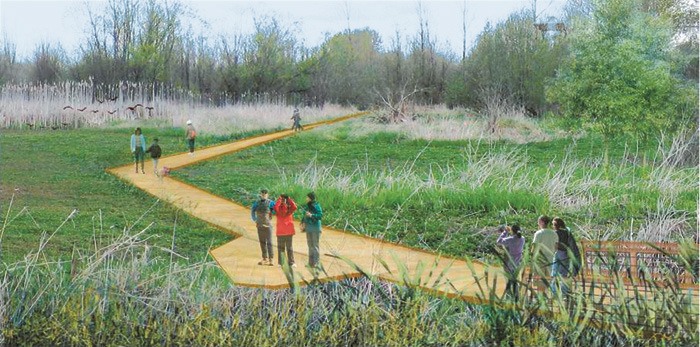Watch the wetlands, let the birds and beasts below bewitch, bother and bewilder you.
And atop a 1,100-foot-long, elevated wooden boardwalk, you can even keep your toes dry.
Sound like a good thing?
City officials think so, which is why they broke ground Tuesday on the boardwalk in the Auburn Environmental Park at the north end of Western Avenue. Construction starts in August and finishes this fall.
The City is developing the first 120 acres of the Auburn Environmental Park to “provide an open space that will offer opportunities for wetland ecosystem restoration, fish and wildlife enhancement, water quality improvement, ecosystem-oriented and sustainable economic development, stormwater detention and flood control, public education, and recreation.”
The effort began years ago when the City was struggling with the problem posed by the wetlands between 15th Street Northwest and West Main Street, which the Washington State Department of Transportation left behind after the construction of State Route 167 in 1970. Instead of fixing the problem, at a cost of about $30 million, the City decided to develop it as a park and into an attraction, capable of drawing in green businesses to its periphery, according to Mayor Pete Lewis.
The City will develop the park in two phases, comprised of about 120 acres each, extending west of Western Avenue to the West Hill.
The City recently approved an agreement between itself and the builder, the Washington State Department of Ecology Washington Conservation Corps, with its workforce of young people. The cost of construction cannot top $45,000.
Funding comes in part from a Washington Wildlife and Recreation Program Urban Wildlife grant from the Washington State Recreation and Conservation Office. According to Elliot Marks, a consultant for the WSRCO, the park is one of more than 1,000 projects the organization has funded throughout the state since 1990.
“They turned something that looked like lemons into lemonade,” Marks said of the City of Auburn.
Plans call for the boardwalk to run along most of the 1,200-foot-long pedestrian trail connecting West Main Street to the bird and wildlife viewing tower on Western Avenue. It will be a six-foot wide, wooden structure atop pin pile foundations. Plans show curbing on both sides and guard rails in places where it rises more than 30 inches above the ground, or where there are areas of seasonal standing water.
This fall, volunteers will plant 2,500 native trees and shrubs in seven planting zones covering 93,000 square feet, along parts of the park bordering the east side of State Route 167 and the north edge of West Main Street.
The state legislature set up the Washington Conservation Corps in 1983 to conserve, rehabilitate and enhance the state’s natural and environmental resources, while providing educational opportunities and meaningful work experiences for young adults between 18 and 25 years of age. It has worked with local, state and federal agencies to finish numerous restoration, recreation, and stewardship projects across the state, among them elevated wooden bridges and boardwalks.
Sponsor organizations, state money and an AmeriCorps grant from the Corporation for National and Community Service fund the WCC, which has 180 members working throughout the state all year.
Debbie Luce, director of the Auburn Tourism Board, thanked the City for “making it easier to promote Auburn” as a destination.


